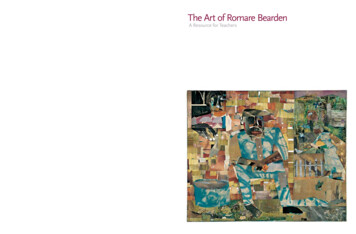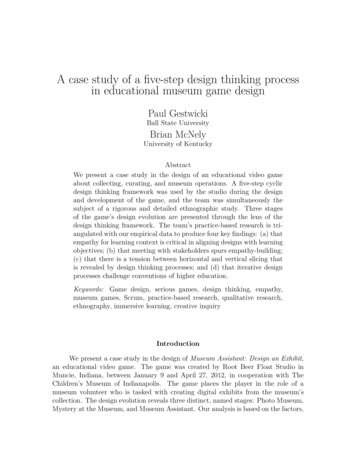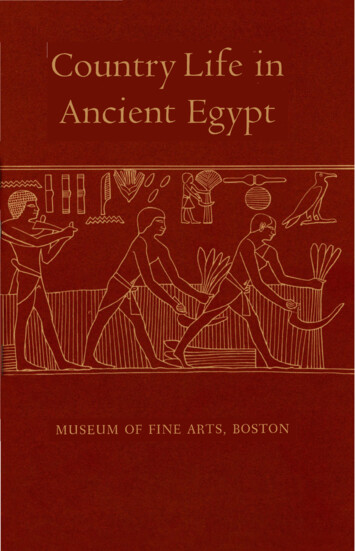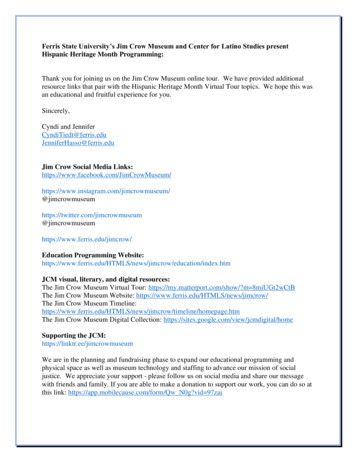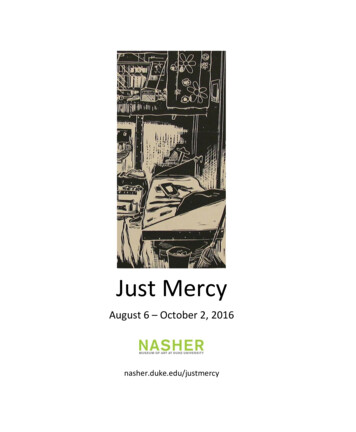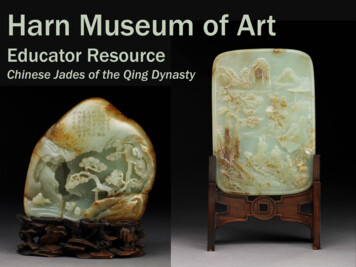
Transcription
Harn Museum of ArtEducator ResourceChinese Jades of the Qing Dynasty
About the ArtworkCollector fashions during the 18th century called for jade bouldersto be left in their natural shapes and carved with landscape andfigural designs. Similar to paintings, these boulders representedminiature worlds that could stimulate the scholar's imagination orprovide a kind of mental retreat.This carved jade boulder depicts a scene set beneath a mountain.A small village is represented by a simple building under pine trees,and two peasants carrying bundles work a field. To the left, a farmerand water buffalo are seen plowing. A poem is inscribed above thescene, written by the Qing dynasty emperor.Emperor Qianlong (1711-1799 C.E.) was a devoted admirer of jadeboulders, and many produced in the Imperial workshops during hisreign are inscribed with poems composed by him. As with poemsincluded on paintings, the poems on the boulders are meant toenrich the viewer's appreciation of the visual imagery.The Imperial poem on this boulder describes the joys of life in aprosperous farming community similar to the scene depicted on thestone. It is translated here by Chinese art scholar, Nick Pearce:Boulder with Landscape and Imperial InscriptionChinese, 18th CenturyNephrite4 11/16 x 4 1/2 x 2 in. (11.9 x 11.4 x 5.1 cm)Bequest of Dr. David A. Cofrin2009.48.228A picture of a bumper harvest made by the emperorMountains and flowers are thereJust to prophesy the good harvest of the year.Village after village are busy with getting in the crops,So is each of the households.People live close to each other,With their chickens and dogs bumping into one another.Villagers gather to talk farming affairs,Much of the traditions and way of life is retained.
Additional ImagesReverse SideDetail
About the ArtworkSymbols of ImmortalityThis carved jade plaque was made to decorate a scholar’s desk. Thescene depicts a favorite subject for artists to represent during theMing and Qing dynasties – an imaginary mountain, Shoushan(Mountain of Longevity), where the Eight Daoist Immortals lived.Mountains have been an important part of Chinese art and culturefor centuries. Stretching skyward, they represent places whereearthly and heavenly ideas or experiences are both possible. Theywere thought of as home to spiritual figures who had gainedeverlasting life.Mountainous landscapes were part of Chinese painting traditions asearly as the Five Dynasties period (907-960 C.E.) and became morewidespread in the 17th and 18th centuries through printed images.As jade carving grew in popularity during this time, mountain sceneswere a natural pairing. Jade not only originates from a mountainouslandscape, but its hardness also supports ideas of indestructabilityand the concept of immortality.A deer included in the bottom, right corner may indicate that thisplaque served as a gift. In Chinese, the name for deer, lu, is ahomophone for lu, an official’s salary. This visual pun serves to wishsomeone success in worldly endeavors. Combined with the image ofShoushan, the Mountain of Longevity, it would have carried themessage of goodwill for a long life and successful career.Table ScreenChinese, 18th-19th CenturyNephrite8 1/16 x 5 11/16 x 5/8 in. (20.5 x 14.4 x 1.6 cm)Bequest of Dr. David A. Cofrin, 2009.48.201
About JadeChinese CultureGeologyJade carving is one of the most important art forms in thehistory of Chinese culture. It’s use can be traced backalmost seven thousand years, beginning in the NeolithicPeriod (ca. 10,000 - 5,000 B.C.E.). At that time, jade wasused to make various types of tools and weapons as wellas ritual objects and personal adornments. Over time, jadeincreasingly became a status material that was used tomake a wide range of functional, ceremonial anddecorative objects, primarily for the ruling class.Jade is a generic name that has been used for a varietyof different hardstones that are predominantly green orwhite in color. The stone that we most commonly refer toas jade is the mineral nephrite.China’s long jade tradition peaked in the Qing dynasty(1644 – 1911 C.E.). During this time, jade was moreplentiful than ever before, and the carvers were moretechnically skilled. They produced a wider variety of formsand styles, and jade objects became integrated into thedaily life of a broad range of people.Nephrite is found in the seams of metamorphic rock,formed geologically under high temperature andpressure. Nephrite deposits exist around the world inparts of Asia, Australia, North America, South America,Europe and Africa. Most of the jade used in China duringthe Qing dynasty came from the Kunlun Mountains inwhat is now Xinjiang Province in Central China.Carving JadeNephrite has a complex crystallinestructure that makes it very difficult tocarve. In fact, nephrite is actually harderthan steel and cannot be cut with a knife.Instead, it is shaped through the processof abrasion – rubbing it with the crushedsands of minerals that are harder thanitself, such as quartz, garnet or diamond.During the Qing dynasty, abrasion sands were glued to handoperated discs and drills. Shaping jade in this way was verylaborious and time-consuming. It sometimes took months oreven years of patient work to create the most elaborate pieces.Nephrite is composed of two other minerals, tremoliteand actinolite, both of which are silicates of calcium andmagnesium and belong to the amphibole group ofminerals, characterized by fibrous or columnar crystals.The name jade is alsosometimes applied toanother mineral, jadeite.Jadeite somewhat resemblesnephrite, but it belongs to thepyroxene family of mineralsand is a silicate of sodiumand aluminum.Image:Nephrite from Lander County, Wyoming.Photograph by Dave Dyet.
Discussion ThemesArt Is “Making Special”Visual Symbols in Chinese ArtThe carved jade boulder and table screen represent examplesof how artists make everyday objects special. The intricatecarvings make these desk decorations important in personal,social and political areas of life. On the carved boulder, aninscribed poem by the emperor makes it even more valuable.These symbols are common in Chinese art and mightbe interesting for a discussion of symbolism.Discuss ways everyday objects are made special inour society. Do you have something that is morespecial because it has words from an importantperson on it? Look at magazines and find aneveryday object that is made special in someways.SymbolismA symbol is a person, place, or thing that standsfor something else, usually an abstract idea oruniversal truth. Symbolism allows people to communicatebeyond the limits of language. Symbols are part ofeveryday life, not just part of art or literature. We see themall around us – as the American flag, a peace sign, aschool mascot, and even traffic signals.Discuss visual symbols that are common in our ownculture. Make a list and then discuss various meaningsassociated with each, include why you think each image orobject came to represent the larger idea.Bamboo - Bamboo is a symbol of vitality because it cansurvive the hardest natural conditions and remainsgreen all year round. It also represents the qualities ofdurability, strength, flexibility and resilience since it willbend in a storm but does not break.Bat - The bat is a symbol of happiness and joy,because the pronunciation for bat, fu, soundsidentical to the word for good fortune. Five batstogether represent the “Five Blessings”: long life,wealth, health, love of virtue and a peacefuldeath.Peach - A symbol of longevity and immortality.Pine - Because it is evergreen and does not lose its leavesin winter, the pine is regarded as a symbol of longevity ornoble endurance in the face of adversity.Dragon - The Chinese dragon is the ultimate symbol ofthe cosmic energy, qi, and the most powerful symbol ofgood fortune. Ranked first among mythical beasts, it canbring rain to parched lands, which in turn representsabundance and relief.Image: Blue and White Dragon Dish, China, Qing Dynasty.Harn Museum Collection.
Lesson: SymbolismDescriptionUnderstanding symbols and how they work is an important skill andvital to understanding literature, art and different cultures. Thislesson will encourage students to recognize and interpret commonsymbols and then create a symbol of their own.Grade Level: Middle grades, 6-8Learning Goals Understand the nature of symbols and how they work. Recognize symbols in everyday life. Discover common symbols in other cultures. Communicate complex ideas through the use of symbols.Introduction: Understanding and Finding Symbols Introduce the concept of symbols and provide examples. Use thediscussion themes and Chinese symbols included in thisresources. Have students work in small groups to create a list of all thesymbols they see in everyday life. Display examples that students have listed and talk about whatthey are used to represent.Activity: Developing Personal SymbolsHave students work individually to develop ideas for aunique symbol to represent their individual identities. Their symbol might represent a personality trait they areproud of, a special skill or ability they have, or a valuethey find important. Have students sketch their ideas. Once a final symbol design is developed, ask studentsto produce a full-color, final image, using color pencils ormarkers and plain white paper. Have students share their personal symbols with theclass, discussing elements of the image and itsmeaning. If possible, display the final projects without names, andlet students see if they are able to guess who createdeach one.Get Creative - Have students use their final design tocreate a t-shirt with their personal symbol. Evaluation Florida StandardsLanguage ArtsStandards for Speaking and Listening - LAFS.6 - 8.SL.1.1, LAFS.6.SL.1.2 Visual ArtsCritical Thinking and Reflection - VA.68.C.1.1, VA.68.C.1.2, VA.68.C.1.3, VA.68.C.3.3Historical and Global Connections - VA.68.H.1.1, VA.68.H.1.3, VA.68.H.1.4VA.68.H.3.2, VA.68.H.3.3Organizational Structure - VA.68.O.2.2, VA.68.O.2.3, VA.68.O.2.4Skills, Techniques and Processes - VA.68.S.1.3 Students will be able to describe a symbol assomething that represents broader ideas or universaltruths.Students will be able to identify common symbolsand explain what they mean.Students will be able to identify aspects of their ownidentity that they value.Students will demonstrate abstract thinking bychoosing and/or creating a visual symbol torepresent themselves.
Resources/BibliographyBooks & Publications-Dissanayake, Ellen. Homo Aestheticus. University ofWashington Press, 1992.-Mason, Charles Q. Spinach Green and Mutton-fatWhite: Chinese Jades of the Qing Dynasty (16441911). University of Florida Press, 2006.-Pearce, Nick. “In a Perfect World: Jade LandscapeCarvings.” Orientations, October 2011, vol. 4, no. 7,64-70.OnlineSymbols in Chinese Art:https://www.britishmuseum.org/pdf/Chinese symbols 1109.pdfSymbols in various cultures:http://www.whats-your-sign.com/
Image: Blue and White Dragon Dish, China, Qing Dynasty. Harn Museum Collection. Symbolism A symbol is a person, place, or thing that stands for something else, usually an abstract idea or universal truth. Symbolism allows people to communicate beyond the limits of language. Symbols are part of everyday life, not just part of art or literature.


